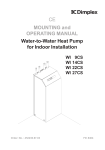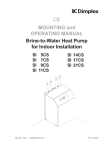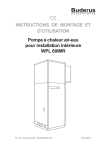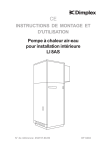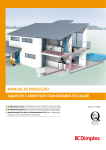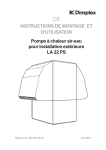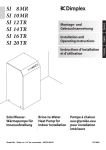Download caution! - Dimplex
Transcript
CE MOUNTING and OPERATING MANUAL Brine-to-Water Heat Pump for Indoor Installation SI 9MSR SI 11MSR SI 5MSR SI 7MSR Order No.: 452232.67.04 FD 8404 1 CONTENTS 1 READ IMMEDIATELY 1.1 1.2 Important Information Legal Provisions and Directives 1.3 Energy-Efficient Use of the Heat Pump 2 PURPOSE OF THE HEAT PUMP 3 4 2.1 Application 2.2 Principle of Operation 3 BASELINE UNIT 4 4 ACCESSORIES 5 4.1 Brine Manifold 5 TRANSPORT 5 6 INSTALLATION 6 6.1 General Information 6.2 Sound Emissions 7 MOUNTING 7.1 7.2 7.3 General Connection on Heating Side Connection on Heat Source Side 7.4 Electrical Connection 8 COMMISSIONING 8.1 8.2 General Preparation 8.3 Procedure for Commissioning 9 CARE/CLEANING 9.1 9.2 Care Cleaning of Heating Side 9.3 Cleaning of Heat Source Side 6/7 7 8 10 MALFUNCTIONS/TROUBLESHOOTING 9 11 DECOMMISSIONING 9 11.1 Shutdown in Summer 11.2 End-of-Life Decommissioning 12 Appendix 10 2 READ IMMEDIATELY 1 READ IMMEDIATELY CAUTION! All power circuits must be disconnected from the power source prior to 1.1 Important Information opening the cabinet. CAUTION! The heat pump is not attached to the wooden pallet. 1.2 Legal Provisions and Directives This heat pump conforms to all relevant DIN/VDE regulations and EU directives. For details refer to the EC Declaration of Conformity in the appendix. CAUTION! The heat pump must not be tilted more than max. 45° (in either direction). The electrical connection of the heat pump must be performed according to and conforming with all relevant VDE, EN and IEC standards. Beyond that, the connection requirements of the local utility companies have to be observed. CAUTION! Do not lift unit by the holes in the panel assemblies! The heat pump is to be connected to the heat source and heating systems in accordance with all applicable provisions. CAUTION! Flush the heating system prior to connecting the heat pump. 1.3 Energy-Efficient Use of the Heat Pump CAUTION! By operating this heat pump you contribute to the protection of our environment. A prerequisite for an efficient operation is the proper design and sizing of the heating system and the heat source system. In particular, it is important to keep water flow temperatures as low as possible. All energy consumers connected should therefore be suitable for low flow temperatures. A 1 K higher heating water temperature corresponds to an increase in power consumption of approx. 2.5 %. Underfloor heating systems with flow temperatures between 30 °C and 40 °C are optimally suited for energy-efficient operation. The supplied strainer is to be fitted in the heat source inlet of the heat pump in order to protect the evaporator against contamination. CAUTION! The brine must contain at least 25 % of a frost and corrosion protection agent on a monoethyleneglycol or propyleneglycol basis. CAUTION! Commissioning of the heat pump must be performed in accordance with the mounting and operating manual of the heat pump controller. CAUTION! Any work on the heat pump may only be performed by authorised and qualified customer service technicians. 3 PURPOSE OF HEAT PUMP BASELINE UNIT 2 PURPOSE OF THE HEAT PUMP 3 2.1 Application The brine-to-water heat pump is designed for use in existing or newly built heating systems. Brine is used as the heat carrier in the heat source system. Ground coils, ground collectors or similar systems can be used as the heat source. BASELINE UNIT The baseline unit consists of a heat pump, ready for connection, for indoor installation complete with sheet metal cabinet, control panel and integrated controller. The refrigeration cycle contains the refrigerant R407C. Refrigerant R407C is CFC-free, non-ozone depleting and non-combustible. All components required for the operation of the heat pump are located on the control panel. The power feed for the load and control current must be fieldinstalled by the customer. The supply lead of the brine pump (to be provided by the customer) must be connected to the control panel. When so doing, a motor protecting device is to be installed, if required. 2.2 Principle of Operation Heating The heat generated by the sun, wind and rain is stored in the ground. This heat stored in the ground is collected by the brine circulating in the ground collector, ground coil or similar device, at low temperature. A circulating pump then conveys the "heated" brine to the evaporator of the heat pump. There, the heat is given off to the refrigerant in the refrigeration cycle. When so doing, the brine cools so that it can again take up heat energy in the brine circuit. The collector loops including brine manifold must be provided by the customer. 1 2 The refrigerant, however, is drawn in by the electrically driven compressor, is compressed and "pumped" to a higher temperature level. The electrical power needed to run the compressor is not lost in this process, but most of the generated heat is transferred to the refrigerant as well. Subsequently, the refrigerant is passed through the condenser where it transfers its heat energy to the heating water. Based on the thermostat setting, the heating water is thus heated to up to 55 °C. Cooling In the Cooling mode, the operating process of the evaporator and condenser is reversed. The heating water transfers the heat to the refrigerant via the condenser that is now working as the evaporator. In the compressor the temperature of the refrigerant is raised. The heat is rejected to the brine, and ultimately to the ground, via the condenser (which acts as the evaporator in the heating mode). 3 1) Condenser 2) Control panel 4 4 3) Compressor 4) Evaporator ACCESSORIES TRANSPORT 4 ACCESSORIES 4.1 Brine Manifold 5 TRANSPORT A lift truck is suited for transporting the unit on a level surface. If the heat pump needs to be transported on an uneven surface or carried up or down stairs, carrying straps may be used for this type of transport. These straps may be passed directly underneath the wooden pallet. The brine manifold ties the individual collector loops of the heat source system into a single main line which is connected to the heat pump. Integrated ball valves allow individual brine circuits to be shut off for venting purposes. CAUTION! The heat pump is not secured to the wooden pallet. CAUTION! The heat pump must not be tilted more than max. 45° (in either direction). For lifting the unit without pallet, the holes provided in the sides of the frame should be used. The side panel assemblies must be removed for this purpose. A commercially available pipe can be used as a carrying aid. CAUTION! Do not use the holes in the panel assemblies for lifting the unit! 5 INSTALLATION MOUNTING 6 INSTALLATION 6.1 General Information 7 As a rule, the unit must be installed indoors on a level, smooth and horizontal surface. The entire base frame should thereby make close contact with the surface in order to ensure adequate sound insulation. Failing this, additional sound insulation measures may become necessary. The heat pump should be located to allow safe and easy maintenance/service access. This is ensured if a clearance of approx. 1 m in front of and to each side of the heat pump is maintained. MOUNTING 7.1 General The following connections need to be established on the heat pump: - supply/return flow of the brine system - supply/return flow of the heating system - power supply 7.2 Connection on Heating Side CAUTION! The heating system must be flushed prior to connecting the heat pump. Before completing the heat pump connections on the heating water side, the heating installation must be flushed in order to remove any impurities that may be present, as well as residues of sealing material, and the like. Any accumulation of deposits in the condenser may result in a total failure of the heat pump. Once the installation on the heating side has been completed, the heating system must be filled, deaerated and pressure-tested. Heating water minimum flow rate The heating water minimum flow rate through the heat pump must be assured in all operating states of the heating system. This can be accomplished, for example, by installing a differential pressure-free manifold or an overflow valve. The procedure for setting an overflow valve is described in the Chapter Commissioning. 6.2 Sound Emissions The heat pump offers silent operation due to efficient sound insulation. To prevent noise transmission to the foundation, a suitable, sound dampening rubber mat should be placed underneath the base frame of the heat pump. To prevent any sound transmission to the heating system it is recommended that the heat pump is connected to the heating system by means of hose sections. Frost protection for installations prone to frost Provided the controllers and circulating pumps are ready for operation, the frost protection feature of the controller is active. If the heat pump is taken out of service or in the event of a power failure, the system has to be drained. In heat pump installations where a power failure cannot be readily detected (holiday house), the heating circuit must contain a suitable antifreeze product. 6 MOUNTING COMMISSIONING power consumption of the heat pump, the technical connection requirements of the relevant electrical utility company as well as all applicable regulations. Details on the power consumption of the heat pump are contained on the product information sheet and the typeplate. The terminals are designed for a max. conductor cross-section of 10 mm˝. 7.3 Connection on Heat Source Side The following procedure must be observed when making the connection: Connect the brine line to the flow and return pipe of the heat pump. CAUTION! The supplied strainer must be fitted in the heat source inlet of the heat pump in order to protect the evaporator against the ingress of impurities. 8 In addition, a powerful vent must be installed at the highest point of the heat source system. The hydraulic plumbing diagram must be observed here. COMMISSIONING 8.1 General To ensure proper commissioning it should be carried out by an after-sales service authorized by the manufacturer. Only then can an extended warranty period of 3 years in total be granted (cf. Warranty service). Commissioning must be carried out in the heating mode. The brine liquid must be produced prior to charging the system. The brine concentration must be at least 25 %. Freeze protection down to -14°C can thus be ensured. Only antifreeze products on the basis of monoethylene glycol or propylene glycol may be used. 8.2 Preparation The heat source system must be vented and be checked for leaks. Prior to commissioning, the following items need to be checked: - All connections of the heat pump must have been made as described in Chapter 7. CAUTION! - The heat source system and the heating circuit must have been filled and checked. The brine solution must contain at least 25 % of an antifreeze and corrosion protection agent on a monoethylene glycol or propylene glycol basis. - The strainer must have been fitted in the sole inlet of the heat pump. - In the brine and heating circuits all valves that could impair the proper heating water flow must be open. 7.4 Electrical Connection - The settings of the heat pump controller must be adapted to the heating installation in accordance with the instructions contained in the controller's operating manual. The following electrical connections must be established on the heat pump: - Connection of the control wire to the control panel of the heat pump via terminals X1: L/N/PE. - Connection of the load wire to the control panel of the heat pump via terminals X6: L/N/PE. - Connection of the brine pump (to be provided by the customer) to the control panel of the heat pump via terminal X1: PE and pump contactor K5: 2/4. All electrical components required for the operation of the heat pump are located on the control panel. 8.3 Commissioning Procedure The start-up of the heat pump is effected via the heat pump controller. CAUTION! Commissioning of the heat pump must be performed in accordance with the mounting and operating manual of the heat pump controller. For detailed instructions concerning the connection and functioning of the heat pump controller refer to the operating manual supplied with the controller. Where the minimum heating water flow rate is assured by means of an overflow valve, the valve must be set to meet the requirements of the heating installation. An incorrect setting may result in various error symptoms and an increased electrical power A disconnecting device with a contact gap of at least 3 mm (e.g. utility company shut-off contactor or power contactor) as well as a 1-pole circuit breaker have to be provided. The required cross-sectional area of the conductor is to be selected according to the 7 COMMISSIONING CARE/CLEANING consumption. To correctly set the overflow valve, the following procedure is recommended: Based on information known to date we recommend cleaning with a 5% phosphoric acid solution or, in the case that cleaning needs to be performed more frequently, with a 5% formic acid. a) Open all heating circuits and close the overflow valve. Determine the resulting temperature difference between supply and return flow. In either case, the cleaning fluid should be at room temperature. It is recommended that the heat exchanger is cleaned in the direction opposite to the normal flow direction. b) Close all of the heating circuits that may also be closed during operation (depending on the type of heat pump usage) so that the most unfavourable operating state - with respect to the water flow rate - is achieved. To prevent acidic cleaning agents from entering the circuit of the heating installation we recommend that the flushing device be fitted directly to the supply and return lines of the condenser. To prevent any damage caused by cleaning agent residues that may be present in the system it is important that the system be thoroughly flushed using appropriate neutralising agents. c) In this operating state open the overflow valve until approximately the same temperature difference exists that was measured under a) when the overflow valve was closed and the heating circuits open. The acids must be used with great care, all relevant regulations of the employers' liability insurance associations must be adhered to. Any malfunctions occurring during operation are displayed on the heat pump controller and can be corrected as described in the operating manual of the heat pump controller. If in doubt, contact the manufacturer of the chemicals! CAUTION! 9 Caution - Heating Technicians ! Depending on the filling water quality and quantity, in particular in the case of mixed installations and plastic pipes, mineral deposits (rust sludge, lime) may form, impairing the proper functioning of the heating installation. A reason for this is the water hardness and oxygen dissolved in the filling waters as well as additional oxygen from the air, which may penetrate via valves, fittings and plastic pipes (oxygen diffusion). As a preventive measure it is recommended that a physical water conditio-ner such as ELYSATOR be used. CARE/CLEANING 9.1 Care The heat pump is maintenance-free. To prevent malfunctions due to sediments in the heat exchangers, care must be taken that no impurities can enter the heat source system and heating installation. In the event that operating malfunctions due to contamination occur nevertheless, the system should be cleaned as described below. 9.3 Cleaning of Heat Source Side 9.2 Cleaning of Heating Side The ingress of oxygen into the heating water circuit may result in the formation of oxidation products (rust). It is therefore important - in particular with respect to the piping of underfloor heating systems - that the installation is executed in a diffusion-proof manner. CAUTION! The supplied strainer is to be installed in the heat source inlet of the heat pump in order to protect the evaporator against conta- mination. The filter screen of the strainer should be cleaned one day after commissioning, thereafter every week. If no more contamination can be noticed any more, the strainer filter can be removed in order to reduce pressure losses. Also residues of lubricating and sealing agents may contaminate the heating water. In the case of severe contamination leading to a reduction of the performance of the condenser in the heat pump, the system must be cleaned by a heating technician. 8 MALFUNCTIONS/TROUBLESHOOTING DECOMMISSIONING 10 MALFUNCTIONS/ TROUBLESHOOTING 11 DECOMMISSIONING 11.1 Shutdown in Summer Shutting down the heating system in summer is effected by switching the heat pump controller to the "Summer" operating mode. This heat pump is a quality product and is designed for trouble-free operation. In the event that a malfunction occurs nevertheless, you will be able to correct the problem yourself in most of the cases. Simply consult the Malfunctions and Troubleshooting table contained in the operating manual of the heat pump controller. 11.2 End-of-Life Decommissioning/ Disposal Additional malfunctions can be interrogated at the heat pump controller. Before removing the heat pump, disconnect the machine from the power source and close all valves. Environment-relevant requirements regarding the recovery, recycling and disposal of service fuels and components in accordance with all relevant standards must be adhered to. Particular attention must hereby be paid to the proper disposal of refrigerants and refrigeration oils. If you cannot correct the malfunction yourself, please contact the after-sales service agent in charge (see Warranty Certificate). CAUTION! All work on the heat pump may only be performed by an authorised and qualified after-sales service. CAUTION! All electrical circuits must be disconnected from the power source prior to opening the equipment. 9 APPENDIX 12 APPENDIX 12.1 Dimensioned Drawing 11 12.2 Equipment Data 12 12.3 12.3.1 12.3.2 12.3.3 12.3.4 12.3.5 12.3.6 12.3.7 12.3.8 Schematics Heating mode .. 5MSR Cooling mode .. 5MSR Heating mode .. 7MSR Cooling mode .. 7MSR Heating mode .. 9MSR Cooling mode .. 9MSR Heating mode .. 11MSR Cooling mode .. 11MSR 13 14 15 16 17 18 19 20 12.4 12.4.1 12.4.2 12.4.3 12.4.4 12.4.5 12.4.6 Wiring Diagram Control, standard controller Control, cooling controller Load Terminal diagr., standard controller Terminal diagr., cooling controller Legend 21 22 23 24 25 26 12.5 Hydraulic Block Diagram 27 12.6 EC Declaration of Conformity 28 12.7 Warranty Certificate 29 10 Heating water return Heat pump inlet 1 1/4" external thread Heat source Heat pump outlet 1 1/4" external thread Heating water supply Heat pump outlet 1 1/4" external thread Heat source Heat pump inlet 1 1/4" external thread 12. 1 Maßbilder APPENDIX: 12.1 DIMENSIONED DRAWING Dimensioned Drawing 11 APPENDIX: 12.2 EQUIPMENT INFORMATION Equipment Information EQUIPMENT DATA for brine-to-water heat pumps for heating purposes 1 TYPE AND COMMERCIAL DESCRIPTIONS 2 MODEL ..5MSR ..7MSR ..9MSR ..11MSR 2.1 2.2 Type reversible reversible reversible reversible Enclosure type acc. to EN 60 529 IP 20 IP 20 IP 20 IP 20 2.3 Installation site indoors indoors indoors indoors 3 PERFORMANCE DATA 3.1 Operating temperature limits: Heating water supply °C max. 55 max. 55 max. 55 max. 55 Cooling, supply °C +8 to +20 +8 to +20 +8 to +20 +8 to +20 Brine (heat source, heating) °C -5 to +25 -5 to +25 -5 to +25 -5 to +25 Brine (heat sink, cooling) °C +5 to +25 +5 to +25 +5 to +25 +5 to +25 Antifreeze agent monoethylene glycol monoethylene glycol monoethylene glycol monoethylene glycol Minimum brine concentration (-13°C freezing temperature) 0,25 0,25 0,25 0,25 3.2 Heating water temperature spread at B0 / W35 K 9,4 9,1 10,6 9,9 3.3 Heating capacity/coeff. of perform. at B-5 / W55 1) kW / --- 4,0 / 2,0 5,4 / 2,1 7,5 / 2,0 9,8 / 2,1 at B0 / W50 1) kW / --- 4,8 / 2,7 6,2 / 2,7 8,8 / 2,8 11,3 / 2,9 at B0 / W35 1) kW / --- 4,9 / 3,9 6,4 / 3,8 9,3 / 4,0 11,6 / 4,1 at B20 / W8 kW / --- 5,4 / 4,6 7,0 / 4,5 9,9 / 4,6 11,4 / 4,6 at B20 / W18 kW / --- 6,6 / 5,3 8,6 / 5,3 12,0 / 5,4 14,1 / 5,3 at B10 / W8 kW / --- 5,4 / 5,6 7,0 / 5,5 9,9 / 5,6 11,6 / 5,7 at B10 / W18 kW / --- 6,8 / 6,7 8,8 / 6,6 12,4 / 6,7 14,1 / 6,5 Sound power level dB(A) 54 55 56 56 3.6 Heating water flow rate at internal pressure difference m³/h / Pa 0,45 / 1900 0,6 / 3300 0,75 / 2300 1,0 / 4100 3.7 Brine flow rate at internal pressure difference (heat source) m³/h / Pa 1,2 / 16000 1,7 / 29500 2,3 / 25000 3,0 / 24000 3.8 Refrigerant; total charge weight Type / kg R407C / 0,9 R407C / 0,9 R407C / 1,25 R407C / 1,6 3.4 3.5 Cooling capacity, coeff. of perform. 4 DIMENSIONS, CONNECTIONS AND WEIGHT 4.1 Equipment dimensions without connections 4) H x W x L mm 800 × 600 × 450 800 × 600 × 450 800 × 600 × 450 800 × 600 × 450 4.2 Equipment connections for heating system inches 1¼" ext. thread 1¼" ext. thread 1¼" ext. thread 1¼" ext. thread 4.3 Equipment connections for heat source inches 1¼" ext. thread 1¼" ext. thread 1¼" ext. thread 1¼" ext. thread 4.4 Weight of transport unit(s) incl. packaging kg 101 104 110 114 5 ELECTRICAL CONNECTION 5.1 Nominal voltage; fusing V/A 230 / 16 230 / 16 230 / 20 230 / 25 5.2 Nominal power consumption 1) kW 1,25 1,68 2,3 2,8 5.3 Starting current with soft starter A 24 26 38 38 5.4 Nominal current B0 W35 / cosϕ A / --- 6 COMPLIES WITH EUROPEAN SAFETY REGULATIONS B0 W35 6,8 / 0,8 9,1 / 0,8 12,5 / 0,8 15,2 / 0,8 3) 3) 3) 3) yes 7 OTHER DESIGN CHARACTERISTICS 7.1 Water inside equipment protected against freezing 2) yes yes yes 7.2 Performance settings 1 1 1 1 7.3 Controller internal / external internal internal internal internal 1) These data characterize the size and performance capability of the system. For economic and energetic reasons, additional factors such as balance point and control need to be taken into consideration. Abbreviations have the following meaning, e.g. B10 / W55: heat source temperature 10 °C and heating water supply temperature 55 °C. 2) The heating circulating pump and the controller of the heat pump must be ready for operation at all times. 3) See EC Declaration of Conformity 4) Please keep in mind that more space is required for pipe connection, operation and maintenance. Subject to technical modifications Issued: 14.04.2004 12 APPENDIX: 12.3 DIAGRAMS 12.3.1 Heating Mode .. 5MSR Water outlet temperature in in [°C] [°C] Wasseraustrittstemperatur Heating capacity in [kW] Heizleistung in [kW] 10 9 Conditions: Bedingungen: Heating water flow rate0,45 0.45m³/h m3/h Heizwasserdurchsatz 3 Soledurchsatz m³/h /h Brine flow rate 1,2 1.2 m 8 35 50 7 6 5 4 3 2 1 0 -10 2.5 -5 0 5 10 Leistungsaufnahme Power consumption (incl. (incl. Pumpenleistungsanteil) proportional pump energy) 15 20 25 30 Soleeintrittstemperatur in[°C] [°C] Brine inlet temperature in Pressure loss in in [Pa] [Pa] Druckverlust 70000 60000 2 50 Evaporator Verdampfer 50000 1.5 40000 35 30000 1 20000 0.5 10000 0 0 -10 -5 0 5 10 15 20 25 30 Brine inlet temperature in Soleeintrittstemperatur in [°C] [°C] COP (incl. proportional pump energy) Leistungszahl (incl. Pumpenleistungsanteil) 8 7 6 5 4 3 2 1 0 0 3 Druckverlust Pressure loss in in [Pa] Condenser Verflüssiger 20000 50 2 3 Brine flow rate in /h] Soledurchfluß in [m [m³/h] 25000 35 1 15000 10000 5000 0 -10 -5 0 5 10 15 20 25 30 Soleeintrittstemperatur in [°C] [°C] Brine inlet temperature in 13 0 0.5 1 1.5 2 3 Heating water flow rate inin[m /h] Heizwasserdurchfluß [m³/h] APPENDIX: 12.3 DIAGRAMS 12.3.2 Cooling Mode .. 5MSR Water outlet temperature in [°C] Wasseraustrittstemperatur [°C] Cooling capacity in [kW] Kühlleistung in [kW] 10 9 Conditions: Bedingungen: Water flow rate 0.45 m3/h Wasserdurchsatz 0,45 m³/h 3 Soledurchsatz 1,2 m m³/h /h Brine flow rate 1.2 8 7 18 6 8 5 4 3 2 1 0 0 2 5 10 15 Power consumption (incl. pump energy) Leistungsaufnahme (incl.proportional Pumpenleistungsanteil) 20 25 30 Brine inlet temperature in [°C] Soleeintrittstemperatur Pressure loss in in [Pa] [Pa] Druckverlust 70000 18 8 60000 Evaporator Verdampfer 50000 1 40000 30000 1 20000 10000 0 0 0 5 10 COP (incl. proportional pump energy) Leistungszahl (incl. Pumpenleistungsanteil) 8 7 6 5 4 3 2 1 0 0 15 20 25 30 Brine inlet temperature in [°C] Soleeintrittstemperatur [°C] 0.5 1 2 2.5 3 Pressure loss in in [Pa] Druckverlust 25000 Condenser Verflüssiger 20000 18 1.5 Brine flow rate in[m³/h] [m3/h] Soledurchsatz 15000 8 10000 5000 0 0 5 10 15 20 25 30 Brine inlet temperature in [°C] Soleeintrittstemperatur [°C] 14 0 0.5 1 1.5 2 3 Heating water flow rate inin[m /h] Heizwasserdurchfluß [m³/h] APPENDIX: 12.3 DIAGRAMS 12.3.3 Heating Mode .. 7MSR Water outlet temperature inin[°C] Wasseraustrittstemperatur [°C] Heating capacity in [kW] Heizleistung in [kW] 12 Conditions: Bedingungen: Heating water flow rate0,6 0.6 m³/h m3/h Heizwasserdurchsatz 3 Soledurchsatz 1,7mm³/h /h Brine flow rate 1.7 10 35 50 8 6 4 2 0 -10 3 -5 0 5 10 Power consumption (incl. pump energy) Leistungsaufnahme (incl. proportional Pumpenleistungsanteil) 15 70000 20 25 30 Soleeintrittstemperatur Brine inlet temperature in [°C] Pressure loss inin[Pa] Druckverlust [Pa] 60000 50 Evaporator Verdampfer 50000 2 35 40000 30000 1 20000 10000 0 0 -10 -5 0 5 10 15 20 25 30 Brine inlet temperature inin[°C] Soleeintrittstemperatur [°C] COP (incl. proportional pump energy) Leistungszahl (incl. Pumpenleistungsanteil) 7 50 4 1 1.5 2 2.5 3 Pressure loss inin[Pa] Druckverlust [Pa] Verflüssiger Condenser 20000 5 0.5 3 Brine flow rate in [m /h] Soledurchfluß [m³/h] 25000 35 6 0 15000 3 10000 2 5000 1 0 0 -10 -5 0 5 10 15 20 25 30 Soleeintrittstemperatur Brine inlet temperature in [°C] [°C] 15 0 0.5 1 1.5 2 3 Heating water flow rate inin[m /h] Heizwasserdurchfluß [m³/h] APPENDIX: 12.3 DIAGRAMS 12.3.4 Cooling Mode .. 7MSR Water outlet temperature in Wasseraustrittstemperatur in[°C] [°C] Cooling capacity in [kW] Kühlleistung in [kW] 14 Conditions: Bedingungen: Water flow rate 0.60,6 m3/h Wasserdurchsatz m³/h 3 /h Brine flow rate 1,7 1.7 m Soledurchsatz m³/h 12 10 18 8 8 6 4 2 0 0 5 10 15 Power consumption (incl. pump energy) Leistungsaufnahme (incl.proportional Pumpenleistungsanteil) 2 25 30 Brine inlet temperature in Soleeintrittstemperatur in [°C] [°C] Pressure loss in in [Pa] [Pa] Druckverlust 70000 18 8 2 20 60000 Evaporator Verdampfer 50000 40000 1 30000 20000 1 10000 0 0 0 5 10 COP (incl. (incl. proportional pump energy) Leistungszahl Pumpenleistungsanteil) 8 7 6 5 4 3 2 1 0 0 15 20 25 30 Brine inlet temperature in [°C] Soleeintrittstemperatur [°C] 0.5 1 2 2.5 3 Pressure loss in in [Pa] [Pa] Druckverlust 25000 Verflüssiger Condenser 20000 18 1.5 Brine flow rate in[m³/h] [m3/h] Soledurchsatz 15000 8 10000 5000 0 0 5 10 15 20 25 30 Soleeintrittstemperatur Brine inlet temperature in in [°C] [°C] 16 0 0.5 1 1.5 2 Heating water flow rate in [m³/h] [m3/h] Heizwasserdurchfluß APPENDIX: 12.3 DIAGRAMS 12.3.5 Heating Mode .. 9MSR Water outlet temperature in [°C] Wasseraustrittstemperatur Heating capacity in [kW] Heizleistung in [kW] 18 16 Conditions: Bedingungen: Heating water flow rate0,75 0.75 m³/h m3/h Heizwasserdurchsatz 3 Brine flow rate 2.3 /h Soledurchsatz 2,3 m m³/h 14 35 50 12 10 8 6 4 2 0 -10 4 -5 0 5 10 Power consumption (incl. pump energy) Leistungsaufnahme (incl. proportional Pumpenleistungsanteil) 60000 Evaporator Verdampfer 50000 35 2 20 25 30 Soleeintrittstemperatur in[°C] [°C] Brine inlet temperature in Pressure loss in [Pa] [Pa] Druckverlust 70000 50 3 15 40000 30000 20000 1 10000 0 0 -10 -5 0 5 10 15 20 25 30 Soleeintrittstemperatur in [°C] [°C] Brine inlet temperature in COP (incl. proportional pump energy) Leistungszahl (incl. Pumpenleistungsanteil) 7 5 50 4 3 2 1 0 -10 -5 0 5 10 15 20 25 30 Soleeintrittstemperatur in [°C] [°C] Brine inlet temperature in 17 1 2 3 4 3 Soledurchfluß [m³/h] Brine flow rate inin[m /h] Pressure loss in in [Pa] Druckverlust [Pa] 18000 16000 14000 12000 10000 8000 6000 4000 2000 0 35 6 0 Condenser Verflüssiger 0 0.5 1 1.5 2 3 Heating water flow rate inin[m /h] Heizwasserdurchfluß [m³/h] APPENDIX: 12.3 DIAGRAMS 12.3.6 Cooling Mode .. 9MSR Water outlet temperature in [°C] Wasseraustrittstemperatur Cooling capacity in [kW] Kühlleistung in [kW] 20 18 Conditions: Bedingungen: Water flow rate 0.75 m3/h Wasserdurchsatz 0,75 m³/h 3 Brine flow rate 2.3 /h Soledurchsatz 2,3 m m³/h 16 14 12 18 8 10 8 6 4 2 0 0 5 10 15 Power consumption (incl. proportional pump energy) Leistungsaufnahme (incl. Pumpenleistungsanteil) 3 20 25 30 Brine inlet temperature in in [°C] [°C] Soleeintrittstemperatur Pressure loss in in [Pa] [Pa] Druckverlust 70000 18 8 60000 Verdampfer Evaporator 50000 2 40000 30000 1 20000 10000 0 0 0 5 10 COP (incl. proportional pump energy) Leistungszahl (incl. Pumpenleistungsanteil) 8 7 6 5 4 3 2 1 0 8 5 10 15 20 25 30 Brine inlet temperature in [°C] Soleeintrittstemperatur 18 1 2 3 4 Brine flow rate in[m³/h] [m3/h] Soledurchsatz Pressure loss in in [Pa] [Pa] Druckverlust 18000 16000 14000 12000 10000 8000 6000 4000 2000 0 18 0 0 15 20 25 30 Brine inlet temperature in [°C] Soleeintrittstemperatur Condenser Verflüssiger 0 0.5 1 1.5 2 3 Heating water flow rate in /h] Heizwasserdurchfluß in [m [m³/h] APPENDIX: 12.3 DIAGRAMS 12.3.7 Heating Mode .. 11MSR Water outlet temperature in [°C] Wasseraustrittstemperatur [°C] Heating capacity in [kW] Heizleistung in [kW] 22 20 35 Conditions: Bedingungen: Heating water flow rate1,0 1.0 m³/h m3/h Heizwasserdurchsatz 3 /h Brine flow rate 3.0 m Soledurchsatz 3,0 m³/h 18 50 16 14 12 10 8 6 4 2 0 -10 5 -5 0 5 10 Leistungsaufnahme (incl.proportional Pumpenleistungsanteil) Power consumption (incl. pump energy) 4 3 15 Pressure loss in in [Pa] [Pa] Druckverlust 50000 50 40000 35 30000 2 20000 1 10000 0 20 25 30 Brine inlet temperature inin[°C] Soleeintrittstemperatur [°C] Evaporator Verdampfer 0 -10 -5 0 5 10 15 20 25 30 Brine inlet temperature inin[°C] Soleeintrittstemperatur [°C] COP (incl. proportional pump energy) Leistungszahl (incl. Pumpenleistungsanteil) 35 8 7 6 5 4 3 2 1 0 -5 0 5 10 15 20 25 30 Soleeintrittstemperatur in[°C] [°C] Brine inlet temperature in 19 1 2 3 4 3 Brine flow rate inin[m /h] Soledurchfluß [m³/h] Pressure loss in in [Pa] [Pa] Druckverlust 18000 16000 14000 12000 10000 8000 6000 4000 2000 0 50 -10 0 Condenser Verflüssiger 0 0.5 1 1.5 2 Heating water flow rate in [m³/h] [m3/h] Heizwasserdurchfluß APPENDIX: 12.3 DIAGRAMS 12.3.8 Cooling Mode .. 11MSR Water outlet temperature in [°C] [°C] Wasseraustrittstemperatur Cooling capacity in [kW] Kühlleistung in [kW] 20 Conditions: Bedingungen: Water flow rate 1.01,0 m3/h Wasserdurchsatz m³/h 3 Brine flow rate 3.0 m /h Soledurchsatz 3,0 m³/h 18 16 14 18 12 8 10 8 6 4 2 0 0 5 10 15 Leistungsaufnahme (incl.proportional Pumpenleistungsanteil) Power consumption (incl. pump energy) 3 25 30 Brine inlet temperature in in [°C] Soleeintrittstemperatur Pressure loss in in [Pa] [Pa] Druckverlust 50000 18 2 20 Evaporator Verdampfer 40000 30000 8 20000 1 10000 0 0 0 5 10 COP (incl. (incl. proportional pump energy) Leistungszahl Pumpenleistungsanteil) 8 7 6 5 4 3 2 1 0 5 10 15 20 25 Brine inlet temperature in [°C] Soleeintrittstemperatur 20 1 2 3 4 Brine flow rate in[m³/h] [m3/h] Soledurchsatz Pressure loss in in [Pa] Druckverlust [Pa] 18000 16000 14000 12000 10000 8000 6000 4000 2000 0 18 8 0 0 15 20 25 Brine inlet temperature in [°C] Soleeintrittstemperatur Condenser Verflüssiger 0 0.5 1 1.5 2 3 Heating water flow rate in /h] Heizwasserdurchfluß in [m [m³/h] >P 4F CAV 0 L 1X 3F 4, A0 Tr 4, A0 Tr 12 opl . 1X 1X 21 opl . C 7 41J N C O 7 7 1A 2A 3A 4A S VE ) UVE ( R PS 11 M - .ö tS 1M -.ötS 31J C N N N C 4 O O O 4 6 5 4 5J DI DI DI DI DI DI DI DI DI C 8 7 6 5 4 3 2 1 1 L/ 2F 0G - 5X CAV 0 2X e r repS = neffo tkatnoK > RPS/SVE CAV42 G - 1J 4C / 3 1J EP N 3X R R 8 6 6J G B B B N 8 7 6 D 51J N C N C 8 O 8 8 7C / 4 1J 2F zH05 - CAV 032 / zteN 61J N N C O O 9 01 9 7J DI DI DI DI DI C 21 11 01 9 9 C N 9 O 11 Mains power supply 2A <P 5F L/ 3F nedrew tgelegna gnunnapszteN eniek frad sE !!gnuthcA V42 na negeil 5X dnu 4X,3X ,2X eiwos 21J sib 1J 1A-5K M 1 1 1A-1K V e r d . 7R 3 9; Ωk CAV42/2X 3J B B B B C 5 C 4 5 4 21J C N N N C 1 O O O 1 3 2 1 4J Y Y Y Y V V 4 3 2 1 G G 0 NALp G N D 2J R xTx/ - 11J R +x Tx/ + CAV 032 1T CAV42 1N 9J G / 2X 1J G G 0 CAV 42 01J 1C DI - 5J 3X CAV 0 V+ G B B B D N 3 2 1 C D 5X J1 to J12 as well as X2, X3, X4 and X5 are connected to 24 V. 2A 0G - 5X 1A 1K 8J DI DI DI C 31 31 H 31 1Y 1A 5K DI DI 1 1 H4 4 1 ON - < 71J - 21 J 81J N C N C 21 O 21 21 Do not connect to mains voltage. 3 ON - > N C N C 1 O 31 3 31 EVS/SPR > Contact open – Lock-out 0G-1J 2N/ 1.2 / G-1J 2N/ 1.2 / 4ON-31J / 2N/ 1.2 1C-21J 2N/ 1.2 / 11J / 1.2 / 21 Caution! APPENDIX: 12.4 WIRING DIAGRAM 12.4.1Control, Standard Controller 41J 5J C N N N C 4 O O O 4 6 5 4 31J CAV 0 DI DI DI DI DI DI DI DI DI C 8 7 6 5 4 3 2 1 1 C 7 N C O 7 7 4J Y Y Y Y V V 4 3 2 1 G G 0 21J C N N N C 1 O O O 1 3 2 1 DNG 3X G B G B N 6 N 5 D D 3J G N D CDV + 3X 01J 2J V+ B B B B D 4 3 2 1 C R x T-/ x- 11J R +x T/ +x 1J G G 0 9J nedrew tgelegna gnunnapszteN eniek frad sE 2N V42 na negeil 5X dnu !!gnuthcA 4X,3X ,2X eiwos 41-,31J dnu 11J sib 1J CAV0 / 0G-1J / 5X / 2.1 CAV42 / G-1J / G-2X / 5.1 Caution! 51J N C N C 8 O 8 8 NALp / 11J / 11J / 2.1 litnev tlahcsmU egeW-4 / 4ON-31J / 1Y / 8.1 )L( CAV032 / 1C-21J / 3F / 8.1 22 J1 to J11 and J13, J14 as well as X2, X3, X4 and X5 are connected to 24 V. Do not connect to mains voltage. APPENDIX: 12.4 WIRING DIAGRAM 12.4.2 Control, Cooling Controller 8.1/ 5K 4 3 S R 3 4 1 2 C ~ 1 1C ~ 1 4 1 2 3 M 11M 7N 7.1/ 1K M 2 1 1M zteN zH05 ~ V032 3 PE N L 6X 23 Mains power supply APPENDIX: 12.4 WIRING DIAGRAM 12.4.3 Load 2nd disable input Contact open = HP disabled 11M-.ötS RPS 22K gnagn ier repS ret2 32K 3A 1M-.ötS rablhäw tsi EW net2 sed noitknuF eiD t r repseg PW = neffo tkatnoK ztühcs r repS -UVE SVE 5J .l o p 2 1 4B 3B <T NEP - )L( 2F 1X 1X 81M 31M 1X N - C N N N C 4 O O O 4 6 5 4 31J He szi abt 01E redo 4J Y Y Y Y V V 4 3 2 1 G G 0 <T Utility company disable contactor t r repseg PW = neffo tkatnoK CAV42 2X 4A CAV 0 .l o p 2 1 N )L( 3F DI DI DI DI DI DI DI DI DI C 8 7 6 5 4 3 2 1 1 0G-1J 41J G-1J Contact open = HP disabled The function of the suppl. heat source can be selected 3X R R R 8 6 5 G B B B N 8 7 6 D 6J 51J 3F N1X EP - 2F Tr A0 4, 1X 40, 3 zH05 - CAV 032 zteN L EP Tr A AM C N C 7 O 7 7 ZM N C N C 8 O 8 8 N1X EP - sierktpuaH -r ehcsiM 9R neßeilhcsuzna fradeB ieb stiesuab Ω 3 9; k 7R 3J B B B B C 5 C 4 5 4 21J tethardre v gitiesskrew R 3 R 2 2J R +x T/ +x R 1 R x T/ x - 3X 6X 9J 1N 1J G G 0 11J 01J + G B B B V D N 3 2 1 C D G N D N L EP 3 zH05 - CAV032 EP/N/L tsaL - zteN 01N NALp CAV42/2X 1A-1K xxxxx 11J / 1.2 .idreV 2V 1V 3 2 1 C N N N C 1 O O O 1 NEP - 1A-5K 1X 2 02K KH 11M factory-wired 2B <P 7J 61J 1X 4 C N N N C 9 O O O 9 11 10 9 N- 3 12M to be field-connected, if required 1X DI DI DI DI DI C 21 11 01 9 9 EP - N- 3 61M Mixer main circuit DI DI 1 1 H4 4 8J 71J 2 12K 3 9E 24 DI DI DI C 31 31 H 31 81J N C N C 21 O 12 21 N1X EP - NAM N C N C 1 O 13 3 1 3 NZM 3 51M Mains 1C-21J 2N / 1:2 4 22M Mains – load APPENDIX: 12.4 WIRING DIAGRAM 12.4.4 Terminal Diagram, Standard Controller M H tuo ctn DNG 3X G B G B N 6 N 5 D D 3J G N D CDV + 3X 2J 01J + B B B B V D 4 3 2 1 C R x T-/ x- 11J R +x Tx/ + 1J G G 0 9J nedrew tgelegna gnunnapszteN eniek frad sE V42 na negeil 5X dnu !!gnuthcA 4X,3X ,2X eiwos 41-,31J dnu 11J sib 1J 2N neßeilhcsuzna fradeB ieb stiesuab tethardrev gitiesskrew Caution! Humidity ethcueF .repmeT 4J 21J C N N N C 1 O O O 1 3 2 1 41M J1 to J11 and J13 - J14 as well as X2, X3, X4 and X5 are connected to 24 V. Do not connect to mains voltage. H tuo M ctn Temp. Humidity Temp. ethcueF .repmeT G ctn 91M Y Y Y Y V V 4 3 2 1 G G 0 3N G 31J ctn 4N 5J CAV 0 DI DI DI DI DI DI DI DI DI C 8 7 6 5 4 3 2 1 1 41J C N N N C 4 O O O 4 6 5 4 5H )N ( CAV032 NALp )L ( CAV032 / 1C -21J / / / N -1X 11J / 2 .1 3F / 8 .1 CAV0 / 0G-1J / 5X / 2 .1 CAV42 / G-1J / G -2X / 5 .1 factory-wired max. 5 sensors nerosneS 5 .xam ϕ ...01R 3 2 1 C 7 N C O 7 7 nretxe nov CAV42 gnunnapssbeirteB 25 to be field-connected, if required ϕ 4 51J N C N C 8 O 8 8 Drawn contact position at J15: N2 and N9 operate in the heating mode 6 5 5N 7 654 3 21 beirtebzieH mi beirtebzieH mi netiebra 9N dnu 2N :51J na gnulletstkatnoK etenhciezeG 9N Operating voltage 24 VAC from external source APPENDIX: 12.4 WIRING DIAGRAM 12.4.5 Terminal Diagram, Cooling Controller APPENDIX: 12.4 WIRING DIAGRAM 12.4.6 Legend A1 A2 A3 A4 Wire jumper, must be removed upon installation of a utility company disable contactor Wire jumper, must be removed if 2nd disable input is used Wire jumper, must be removed if a motor protection contact for primary pump is used Wire jumper, must be removed if a motor protection contact for the compressor is used Open wire jumpers or contacts mean: lock-out or malfunction B2* B3* B4* Pressostat low pressure, brine Thermostat, hot water Thermostat, swimming pool water C1 Operating capacitor, compressor E9* E10* Electr. immersion heater, hot water Suppl. heat source (boiler or electr. heating element) F2 F3 F4 F5 Load fuse for N1 relay outputs across J13 Load fuse for N1 relay outputs across J15 to J18 at N1 and -J12 at N2 Pressostat high pressure Pressostat low pressure J1...J18 J1...J15 Terminal connector at N1 (standard controller) Terminal connector at N2 (cooling controller) K1 K5 K20* K21* K22* K23* Contactor, compressor Contactor, primary pump (M11) Contactor for E10 Contactor for E9 Utility company disable contactor SPR auxiliary relay M1 M11* M13* M14* M15* M16* M18* M19* M21* M22* Compressor 1 Primary pump Heating circulating pump, primary circuit Heating circulating pump - heating circuit 1 Heating circulating pump - heating circuit 2 Auxiliary circulating pump Hot water circulating pump Swimming pool water circulating pump Mixer, main circuit Mixer, heating circuit 2 N1 N2 N3/N4* N5 N7 N9* N10* Standard controller (pCO2) Cooling controller (pCO1) Room units for dew point control Dew point monitor Soft start control Room thermostat Remote control station R1 R2 R3 R5 R6 R7 R8 R9 R10* External sensor Return sensor Hot water sensor (as an alternative to the hot water thermostat) Sensor for heating circuit 2 Freeze protection sensor (brine) Coding resistor 3k9 Frost protection sensor, cooling Frost protection sensor, heating Humidity sensors of N5 T1 Safety isolating transformer 230/24V AC-50V A X1 X2 X3 X5 X6 Terminal stripmains control L/N/PE-230V AC-50 Hz/fuses/N and PE-terminal block Terminal strip 24V AC-terminal block Terminal strip GND terminal block for sensors Terminal strip 0V AC terminal block Terminal strip power supply L/N/PE-230V AC-50 Hz Y1 4-way reversing valve Abbreviations: EVS SPR Utility company disable input Supplementary disable input MA* MZ Mixer OPEN Mixer CLOSED * Components to be supplied by the customer 26 4.0 A slow 4.0 A slow N1-B6 T (R5) 2 M N1-N05 (M13) 27 T N1-B2 (R2) N1-B5 (R9) T 3 EV N1-N04 (E10) N1-N012/N013 (MA/MZ M22) N1-N011 (M15) TC TC N1 1 N2 N2-N01 (M14) N1-N06 (M18) T N3 / N4 5 WW M KW 4 T Flexibler Anschlußschlauch Flexible connecting hose Temperaturfühler Temperature sensor Schmutzfänger Strainer Dreiwegemischer Three-way mixer Wärmeverbraucher Heat consumer N1-N03 (M11) Absperrventil mitwith Entwässerung Shut-off valve drain Shut-off valve check valve Absperrventil mitwith Rückschlagventil Thermostat/manual valveVentil Raumtemperaturgesteuertes Expansion vessel Ausdehnungsgefäß N1-B1 (R1) EV N1-N010 (E9) N1-B3 (R3) TC Umwälzpumpe Circulating pump Sicherheitsventil Safety valve Absperrventil Shut-off valve E9 Heizungspumpe 2ter Heizkreis Heating system pump, (elektronisch heating circuitgeregelt) 2 Warmwasserumwälzpumpe Hot water circulating pump Heizungsumwälzpumpe Heating circulating pump Umwälzpumpe fürfor Heizund Kühlbetrieb Circulating pump heating and cooling (elektronisch geregelt) controlled) operation (electronically Tauchheizkörper Immersion heater,Warmwasser hot water 2ter Wärmeerzeuger Suppl. heat source Soleumwälzpumpe Brine circulating pump Außenwandfühler External wall sensor Rücklauffühler Return sensor Warmwasserfühler Hot water sensor Rücklauffühler Heizkreis Return sensor,2ter heating circuit 2 R5 Electric distribution Elektroverteilung Cold water Kaltwasser EV Hot water Warmwasser WW 8 7 6 5 4 3 2 1 7 8 6 Heat pump Wärmepumpe Buffer tank Pufferspeicher Heat pump controller Wärmepumpenregler Elektroverteilung Electric distribution Warmwasserspeicher Hot water storage tank Erdwärmesonden Ground collectors Soleverteiler Brine manifold Solesammler Brine collector Mixer OPEN heating circuit 2 Mischer AUF – - 2ter Heizkreis Mixer CLOSED – heating circuit 2 Mischer ZU - 2ter Heizkreis MZ MA KW Frost protection sensor, heating Frostschutzfühler Heizwasser R9 R3 R2 R1 N2 Standardregler (mit Display) Standard controller (with display) Kühlregler (ohne Display) Cooling controller (without display) N3/N4 Room Raumklimastation climate control station N1 M18 M15 M14 M13 M11 E10 APPENDIX: 12.5 HYDRAULIC BLOCK DIAGRAM Hydraulic Block Diagram APPENDIX: 12.6 EC DECLARATION OF CONFORMITY EC Declaration of Conformity Declaration of Conformity The undersigned KKW Kulmbacher Klimageräte-Werk GmbH, Division Dimplex Am Goldenen Feld 18 D-95326 Kulmbach hereby confirm that the design and construction of the product(s) listed below, in the version(s) placed on the market by us, conform to the relevant basic requirements of the applicable EC directives. This declaration becomes invalidated if any modifications are made to the product(s) without our prior authorization. Designation of the product(s): EC Directives: Brine-to-water heat pumps EC Low Voltage Directive (73/23/EEC) EC EMC Directive (89/336/EEC) Pressure Equipment Directive (97/23/EEC) for indoor installation with R407C Type(s): Harmonized EN Standards: SI 5MSR SI 7MSR SI 9MSR SI 11MSR Requirements of category II Order No.: National Standard/Directives: 342 360 342 370 342 380 342 390 Kulmbach, 27.01.2004 General Manager 28 Technical Director Notes Notes Notes KKW Kulmbacher Klimageräte-Werk GmbH Division Dimplex Am Goldenen Feld 18 D-95326 Kulmbach Subject to technical modifications Fax (0 92 21) 709-589 www.dimplex.de 32
































